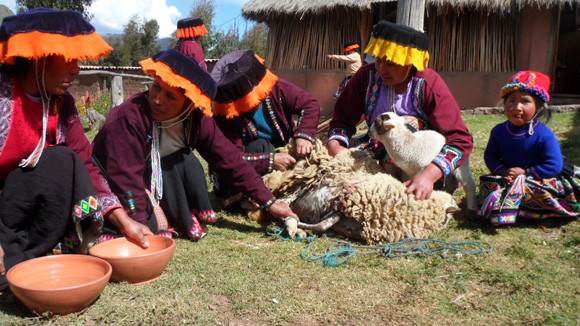Sitting next to a pile of luggage in the back of a 10-seater van as we wound our way up and up through the Andes Mountains, I hoped nobody would turn around and notice my eyes were closed. I might have been able to pass my shuttered state off as jet lag -- after all, I had just arrived to Peru by plane a few hours prior. But it wasn't a lack of sleep that kept me in this state; it was the fear of looking out the window at the rocky chasm just inches from our van's tires. Our driver was a true professional, snaking the vehicle along a dirt path that came death-defyingly close to the ridge at rapid pace. But me? I was just an amateur passenger, a first-time visitor who wanted to take it all in but instead found myself squeezing my eyelids shut and grasping the vinyl seating until my knuckles turned translucent white.
Without warning, our van skidded to a stop. Gripping the seat even tighter, I opened my eyes just in time to see the door fly open. Out of a cloud of red dust appeared a woman dressed in a rainbow of woven colors, her outfit capped with a flat-top hat that looked like a cupcake paper turned upside-down. In a wrap on her back she carried a baby that couldn't possibly have been older than nine months. As the woman took a seat in the van, another member of our tour group asked if she might snap a picture, raising her camera and pointing to it. The woman didn't understand the request in English or Spanish, but smiled warmly and nodded at the hand gestures. As it turns out, this was no ordinary hitchhiker; this woman was from the Amaru community, the Andean village we were on our way to visit.
After a few more minutes winding up the mountain we arrived at our destination. Hopping out of the van, I took note of the surroundings: a dirt road surrounded by modest homes made of cement. Further out, a patchwork of small fields on the sloping mountains was being cultivated by farmers. As we passed through an archway decorated with flowers, more women dressed like our hitchhiker friend greeted us by placing magenta garlands made out of Peru's national flower, the bell-shaped qantu, around our necks and sprinkling us with white flower petals. The women seemed genuinely excited to have us, hurriedly buzzing around like bees getting ready to show us their craft. With a translator on hand, a few of the women spoke about the importance of the textiles in their native tongue, a form of Quechua (the common ancestral language of the Andes). After thanking us for our interest in learning about their traditions, the demonstration began.
First came the shearing of a sheep. After corralling her and binding her feet with yarn, three women held the sheep down and took a knife to her wool. The sheep wasn't too excited about this -- and neither would I have been, judging solely by the dullness of the blade -- and began shrieking wildly. Even her young lamb swooped in to see what was the matter, but the women assured us it didn't hurt the animal -- she was just scared.
Next one of the women showed us how they clean the wool using only water. The process started with an empty bowl and one full of water. Placing the wool in the empty bowl, the woman covered it in a little water and rinsed it until the water turned black. Then she dumped the dirty water and repeated the process until the water turned murky brown and eventually clear, ensuring the wool was nice and clean. No bleach, no soap -- just some water and a whole lot of patience.
Most fascinating to me was what came next. The women showed us how they make natural dyes from various flowers and minerals. For each specimen they showed us the corresponding fabric that would result. From browns and burnt orange to bold greens and blues, I was in awe that they could create such intense hues.
In a nearby pot boiling with water over hot coals, the women demonstrated how to dye the fabric using just the hot water, wool, and some flowers. The colors that resulted after just a few minutes in the hot pot were remarkably vivid.
The women also showed us how they turn the wool into yarn, stretching it out on spindles. Everything was done by hand without the aid of machines. I should also note that there were no men present -- they were all out working in the fields.
Finally, it was time to weave. The Amaru women explained that the geometric patterns in the textiles include very old codes that tell about the community's identity, customs, and desires. Even the young girls wanted to join in weaving, with the adorable girl pictured above stealing the show (by far, she was the most photographed person in the community that day!). Watching the women pass down the tradition from generation to generation made me think of my own grandmother, a seamstress who knitted, sewed, embroidered, and crocheted. Unfortunately, without her around to show me how to create textile masterpieces, I've always found that I have little patience to learn myself. Still, it's interesting to note that whether in the suburbs of Cleveland or high in the Andean mountains, many of our traditions are similar.
The end result are these beautifully intricate textiles. The Amaru women create blankets, tapestries, scarves, purses, jewelry, and dolls. I purchased a bracelet and have been proudly showing it off, explaining that I know exactly where it came from -- from the sheep to the finished product. In the end, spending time with the Amaru community was well worth the stress of the harrowing drive into the Andes.
Visiting Peru and want to meet the Amaru Women yourself? The community is located about 30 minutes by car from Cusco and five minutes from Pisac. Tours (including a demonstration and lunch) and homestays can be booked through La Tierra de los Yachaqs ("The Land of the Wise"), a community-based tourism project.









